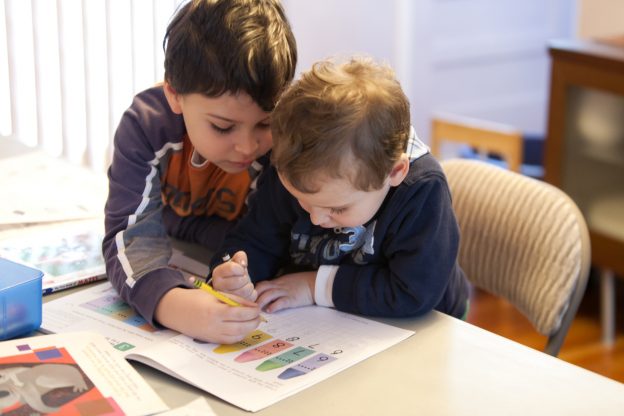
Special Education
How Homeschooling Can Make Accommodations and Modifications Easier for Students with Learning Disabilities
Let’s face it: learning disabilities hurt. Not only do they have an impact on a child’s confidence, but the struggle is also a difficult one for us as parents. It’s tough not to play the comparison game when your child is struggling and others make it look so easy. If we wrestle with those thoughts, imagine what our kids are thinking! That's where homeschooling comes in. One way to take control of this situation is to homeschool. It’s an incredibly intimidating but rewarding step that has the power to change the future for our child. And for many of us, the game plan involves more than just choosing a curriculum. It includes accommodations, modifications, and even adjusted schedules to aid our children with their special education needs. Both accommodations and modifications give children with special needs a chance to earn their best results.Accommodations
For those students who are at grade level academically but struggling to demonstrate what they know, success might be just a few accommodations away. Accommodations do not fundamentally alter or lower the standard of the course or test that you are using. Instead, they allow you to leverage your child’s strengths and adapt how you approach teaching and learning in order to help your child move forward. How can you make some quick accommodations to increase your child’s potential for success? By homeschooling, you have already made an accommodation — removing the distraction, the comparison game, the need to sit in one place for prolonged periods of time, the stress that all too often comes as a result of teasing or feeling different, and/or the cruel peers who just don’t have the grace or maturity to be kind to those who struggle. However, there are additional accommodations you can make by making adjustments to your homeschooling style. Here are just a few:- Slow down the pace a bit to ensure that your child understands the material.
- Provide a few additional opportunities to practice a skill or concept to ensure mastery.
- Give your child all the time needed to take a test or complete an assessment.
- Change up the environment. If your child does better outside, head outdoors and tackle those tough topics or skills in a place where your child learns best.
Modifications
Sometimes it takes more than just a few accommodations to set the stage for success. You may need to actually change the academic level, requirements, or the total scope of a course. In many cases, determining the right modifications requires some initial testing and understanding. That testing can provide insight into some important questions:- How does your child best process and retain new information?
- Are there specific academic gaps that need to be filled before you can move on?
- Is your child working at grade level in each subject? If not, don’t be afraid to select a course designed for a lower grade level. Remember, your goal is to help your child reach success. Modifications can be the foundation needed to plug academic gaps, increase confidence, and move forward.
Action Plan
As parents, we need to overcome the fear of the term learning disability. While there are many different learning disabilities that require specific accommodations, the general strategies remain the same. Taking action starts with a basic learning plan centered around your child’s strengths, struggles, learning style, and personality. A great place to start is with a learning style assessment (like the one offered by Bridgeway Academy) that provides a detailed report on what works, what doesn’t, and how to adapt learning material to your child. Develop a contingency plan for how you can shift the focus when your child hits those moments where learning just stops. If you plan this ahead of time, it takes away your stress when emotions are high. Some ideas that worked for us include the following:- Take a break to play a favorite game.
- Create a physical education competition, such as how many sit-ups, push-ups or pull-ups you can do without stopping. You get a double benefit here — a recharge to the brain and some much-needed exercise.
- Take a snack break or even a media break, if that relaxes or motivates your child.
Simple Learning Strategies
- Take the time you need to cover each unit effectively and/or ensure that your child gains those foundational skills necessary for future success. Allow extra time for checking and double-checking work. Mastery occurs only with review, so reinforcing by reviewing the last lesson or unit before tackling the next one can be a great tool to help kids retain what they’ve learned. Increase the chance for success by previewing the next lesson, making special note of new words and terminologies or expectations.
- Cut down the volume of writing, spelling, or math at any one time and spread it out over an entire day. Think of it as three one-mile walks at various times of the day rather than a rushed and exhausting three-mile sprint.
- Use visual aids as often as possible. Studies show that we retain up to 55 percent more of what we learn through visual information. Use diagrams, graphs, pictures, large letters of the alphabet, colors, and more to keep the learning interesting and increase memory.
- Build self-esteem through independent practice time. When young learners have the opportunity to succeed on their own, it pushes up the confidence meter. Since a lack of confidence is one of the leading symptoms of a learning disability, getting deliberate about creating opportunities for independence and success is huge.
- Use positive reinforcement. Everyone loves praise. But be sincere — kids know when they are out of line or when they haven’t quite met expectations. Praise the effort and encourage the next step. And always remember, you will quickly begin to see those gifts and abilities that make your child so unique. Allow time to pursue those passions, and you will begin to see significant results.



